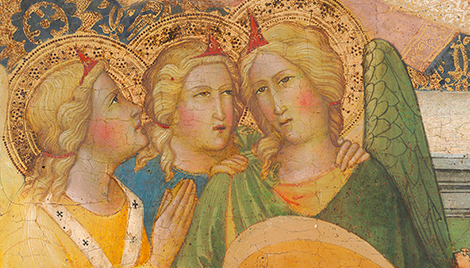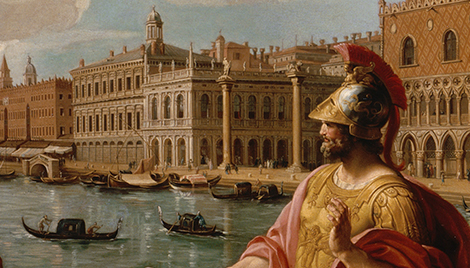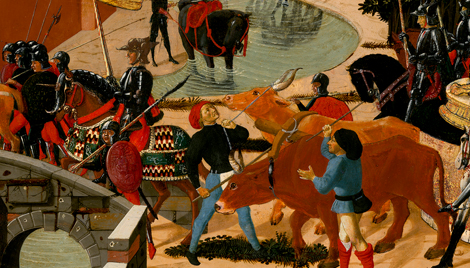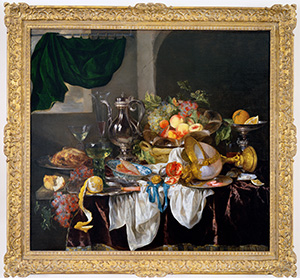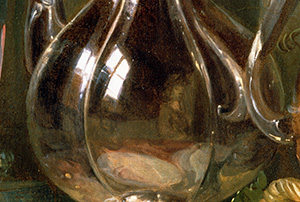Banquet Still Life
Banquet Still Life
- Artist
- Abraham Hendricksz van Beyeren
- Artist Dates
- 1620/1621-1690
- Artist Nationality
- Dutch
- Title
- Banquet Still Life
- Date
- c. 1653-55
- Medium
- oil on canvas
- Dimensions
- 105.4 x 114.4 cm (41-1/4 x 45 in)
- K Number
- K1986
- Repository
- Seattle Art Museum
- Accession Number
- 61.146
- Notes
Provenance
Francis Charles Hastings Russell, 9th Duke of Bedford [1819-1891], Woburn Abbey, Bedford, England, by 1890 as Jan Weenix; by inheritance to George William Francis Sackville Russell, 10th Duke of Bedford [1852-1893], Woburn Abbey; by inheritance to Herbrand Arthur Russell, 11th Duke of Bedford [1858-1940], Woburn Abbey; by inheritance to Hastings William Sackville Russell, 12th Duke of Bedford [1888-1953], Woburn Abbey; (his sale, Christie's, London, 19 January 1951, no. 7; (William Sabin). (David Koetser Gallery); sold to the Samuel H. Kress Foundation on 20 January 1954; gift 1961 to the Seattle Art Museum, no. 61.146.
Catalogue Entry
Abraham Hendricksz van Beyeren
Banquet Still Life
K1986
Seattle, Washington, Seattle Art Museum (D37/B4687.1), since 1954. Oil on canvas. 41 1/2 x 45 in. (105.4 x 114.4 cm.). Signed on table ledge at extreme left: ABF. Relined and restored c. 1925; very well preserved. Seattle, 1954, p. 64. Reproduced in color in Fêtes de la Palette, Thanksgiving 1962 -Twelfth Night 1963, Isaac Delgado Museum of Art, New Orleans, on cover and pl. 59. A slab partially covered with a rich purple velvet, goldfringed cloth (covered in turn by a smaller white one) is in an interior with an arched opening at the upper right. A window with a raised green curtain is at the upper left beyond which sky is seen. The table is crowded with precious objects and luxurious comestibles including crab on a dish at the left, glacéed foods in a blue and white Oriental style bowl at the center,(1) a partially peeled orange in the foreground on a rich, scalloped silver plate; pomegranate, shrimp and oysters at the right; an orange and a lemon slice on a footed salver at the upper right; an elaborate nautilus cup on its side (a merman at top and bottom),(2) a silver repousse dish with grapes, figs and peaches at the center placed upon a wicker basket. A silver coffee pot (a reflection shows the artist's studio with van Beyeren at his easel) is at the left near a rum glass and two delicate Façon de Venise wineglasses. This still life refers to the concept of Vanitas – the futility of earthly riches in view of the eternal verities – indicated by the open watch prominently placed at the center foreground of the composition.(3) The watch is tellingly juxtaposed with an open pomegranate symbolizing fecundity, regal power and concord. The fallen nautilus cup, together with the empty stone niche, also indicate transience and the sepulchral. The Kress canvas was attributed by Scharf to Jan Weenix in 1890; presumably the monogram at the left was obscured at the time.(4) According to Fuller, 'Nothing typifies the prosperity of 17th century Holland more than some of the still life paintings portraying with amazing realism and detail, as in this instance, a complexity of luscious foods and objets d'art. In this great tour de force the artist to show his skill selected a vast variety of textures to depict, from the complex interior of a verge watch to the open oyster with its pearl. No problem was too difficult, from the pearly nautilus shell in its Baroque gold mounting to the half-filled glasses and the gleaming silver ewer reflecting the room's interior. Many of the items such as the Chinese blue-and-white porcelain bowl are from his own studio, for the same objects in successive arrangements can be recognized in other paintings by van Beyeren.'(5) Bergström noted that van Beyeren's first-known Banquet-Piece (Munich, Alte Pinakothek) signed and dated 1653 includes the same nautilus cup and tazza (which are earlier in date than the rest of the silver), two silver dishes and the watch of K1986. Several of the same props reappear in a signed canvas dated 1654 (ex coll. Frits Lugt) and in one dated 1655 (Worcester, Mass., Worcester Art Museum).(6) This opulent, splendidly orchestrated still life is partly rooted in the Flemish tradition. Its theatrical presentation, with the raised curtain at the left, suggests Rubensian origins, removed from the more austere approach of the North Netherlands. Still lifes such as these follow the approach of Jan Davidsz. de Heem (1606-83/4) who, born in Utrecht, spent much of his life in Antwerp, where his magnificent still lifes were influenced by the art of Flanders. By including himself and his studio (reflected in the coffee pot) van Beyeren places his art with the earthly vanities and the senses of taste, touch and sight. Predominantly a painter of fish and marine subjects, van Beyeren was especially drawn to the nautical associations of the silvergilt cup with its merman and seashell motif; Kalf, a contemporary master of the same genres, was also fond of including a nautilus cup in his banquet pieces. Provenance: Duke of Bedford, Woburn Abbey, Bedfordshire, listed as by Jan Weenix, p. 267, Cat. No. 431 in a Descriptive and Historical Catalogue of the Collection of Pictures at Woburn Abbey, by Sir George Scharf, London, 1890. Sold in London, Christie's, 19 Jan. 1951, p. 5, Cat. No. 7. New York, David M. Koetser. Kress acquisition 1954, exhibited –Washington, D.C., National Gallery of Art, Exhibition of Art Treasures for America from the Samuel H. Kress Collection, 10 Dec. 1961-4 Feb. 1962, Cat. No.8. New Orleans, Louisiana, Isaac Delgado Museum of Art, Fêtes de la Palette, 1962-3, Cat. No. 18.
References
(1) For the inclusion of Oriental ceramics in Dutch painting see A. I. Spriggs, 'Oriental Porcelain in Western Paintings, 1450-1700', Transactions of the Oriental Ceramic Society, 1964-5, 1965-6, pp. 73-87. (2) For seventeenth-century nautilus cups close in style to the one in K1986 see Th. M. Duyvene de Wit-Klinkhamer 'Een Rotterdamse Nautilusbeker', Bulletin Museum Boymans, Rotterdam, V, 1954, pp. 93-9. (3) For the Vanitas theme, see Charles Sterling, Still-life Painting from Antiquity to the Present Time, Paris, 1959, pp. 50-6. (4) Sir George Scharf, A Descriptive and Historical Catalogue of the Collection of Pictures at Woburn Abbey, London, 1890, p. 267, Cat. No. 431. (5) William C. Suida and Richard E. Fuller, European Paintings and Sculpture from the Samuel H. Kress Collection, Seattle Art Museum, 1954, p. 64. (6) Ingvar Bergström, Dutch Still-life Painting, London, 1956., fig. 199, p. 239, for the Munich painting; fig. 198, p. 238, for the Worcester Museum canvas. The cup and coffee pot are both shown in a van Beyeren still life once owned by Arthur Kauffmann, 21 Grafton Street, London, reproduced in the advertising supplement of the Burlington Magazine, XCIV, Dec. 1952. They are both included with several of the other props of K1986 in another canvas (S. Larsen-Menzel Collection, Wassenaar, reproduced in Meester Werken uit vier Eenwen, 1400-1800, Rotterdam, Museum Boymans, 25 June-15 Oct. 1938, p. 61, fig. 91, Cat. No. 56). The coffee pot is also seen in a banquet piece of 1654 (Rotterdam, Boymans-van Beuningen Museum) reproduced by Jakob Rosenberg and Seymour Slive, Dutch Art and Architecture: 1600-1800, Baltimore, 1967, pl. 168B.

